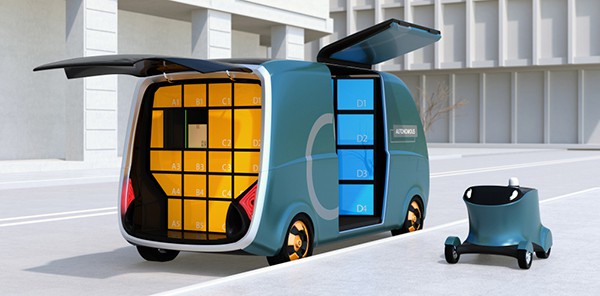By: Lidia Yan, Forbes Technology Council
Automation is regarded as the next great horizon for trucking. Experts predict swelling pressures on the supply chain in recent years will usher in new innovation, thanks to technologies like AI, IoT, advanced data analytics and machine learning. In the economic pressure cooker that is the Covid-19 pandemic, the need for these types of solutions has become increasingly apparent.
Truck drivers who work long hours have faced mounting health and safety risks, and the supply chain has become reliant on faster, more traceable delivery methods. Thus, logistics and automotive behemoths like Amazon have poured millions into the most obvious solution: self-driving trucks. Those investments have dominated the news, from fears over potential job losses to hopes for a digitally-enabled future. Still, experts anticipate that widespread commercial deployment of autonomous long-haul trucks might be decades away.
While self-driving trucks receive widespread interest, that’s just the tip of the iceberg in terms of the potential for automation to improve efficiency across the supply chain. As co-founder of a trucker-centric marketplace and end-to-end logistics solution, I know the nuances of the industry-required knowledge from technology providers. The trucking profession will continue to require human intervention, and areas such as shipping, port operations and fleet management offer more immediate opportunities for modernization.
Identifying Critical Pain Points
To improve efficiency and operations in the trucking industry, technology providers must first understand and identify pain points, and where the limits of the human mind offer an opportunity for improved efficiency through automation.
At the port, one challenge is the organization of yard space or container storage. Containers constantly come and go and must abide by specific requirements, depending on their content or company. Other complicating factors, like container stacking and pandemic-related demand surges, make this a mentally strenuous task.
Typically managed by an employee, yards are organized in simplistic ways to make operations manageable as high volumes of containers enter and exit the port. Automated programs, however, can ingest appointments from drivers, identity availability and prioritize the movement of containers in real time. This is one area of the supply chain where automation can alleviate some of the heavy lifting.
The same problem arises in dispatcher operations when the container hits the road. Human dispatchers are responsible for navigating what is commonly referred to as the “traveling salesman problem.” Dispatchers face the challenge of finding the most efficient route for a container and a driver to reach multiple destinations on schedule.
Dispatching is the point where complicating factors intersect between the port and the last mile, and the mental logistics of coordinating locations and loads is incredibly taxing. An experienced dispatcher might, for example, dispatch 100 loads per day. An automated program or “robo-dispatcher” could execute the same function at potentially 100 times that rate with greater accuracy.
Barriers To Adoption
Legacy methods like manual scheduling, pen and paper reporting or phone calls have historically dominated the trucking industry. While that reality is changing, technology providers face concerns over potential job losses as a result of automation, as well as realistic expectations for the efficacy and reliability of those solutions — a common criticism of self-driving trucks.
Consider the robo-dispatching example. Drivers and dispatchers often have working relationships that go beyond the baseline function of matching loads and routes. Dispatchers develop trusting relationships with drivers and take their personal preferences into account beyond price or rate.
To drivers, some ports and routes are preferred. A dispatcher can weigh the pros and cons, troubleshoot problems at the port and provide a personal work relationship that is rare in the often-solitary trucking profession. Existing technologies, like automated re-load solutions that help drivers identify nearby loads, have established the opposite precedent: They often consist of left-over, unwanted or non-premium loads to haul.
Therefore, the success of automation lies in its ability to blend efficiency with the human touchpoints that matter most to drivers and carriers. By automating the technically challenging elements of a job like route matching and dispatching, with room for human oversight, the industry can improve trust and overcome skepticism related to automated technologies.
What An Automated Future Looks Like In The Real World
At TraPac’s container terminal in Los Angeles, this technology is already operating — with great success. TraPac has automated port operations with AI-enabled, robotically-powered systems for horizontal transport and automated cranes for container stacking and on-dock rail operations.
At TraPac, containers are driven via automated rail systems without the need for human intervention to determine the placement, movement and organization of containers. Because of this, they organize their yard differently than most, and empty containers and loads waiting for pickup can be neatly organized, identified and moved about. I expect innovations like those at TraPac will continue to pique investor interest, as bottlenecks beyond dispatcher burn-out offer immense opportunity for automation throughout the supply chain.
At the terminal, free-flow areas, where a single customer’s containers lie waiting for driver pickup, face widespread scheduling challenges to coordinate appointment windows and dedicated lanes at the terminal. They are convenient for drivers, helping avoid delays and fees for the carrier, but the complexity arises in knowing when a free flow can be set up.
In the yard, a “gray pool” allows a driver dropping off a container to take any empty container they’d like back to the terminal, reducing operation costs for trucking companies, brokers and facilities management. While more convenient, challenges with billing and operational costs on the trucking side make this potentially simple option less efficient. In terms of financials, accessorial accounting requires continuous reconciliation of charges accruing from drivers during their transport resulting from wait times, chassis splits and fuel surcharges, making the minutiae of the accounting process complex to manage.
Automation can alleviate these types of issues, make the underlying processes more efficient and free employees to have more mental capacity to manage the operations at each stop along a container’s journey. Opportunities for automation continue to drive the trucking industry toward a more digitized future, and tech providers that offer the advantage of those advancements will be offering benefits like improved efficiency, streamlined operations and overall cost reduction.
Yan, L. (2021). Automation is the future of trucking, but it’s not all about autonomous driving. Forbes Technology Council. https://www.forbes.com/sites/forbestechcouncil/2021/05/03/automation-is-the-future-of-trucking-but-its-not-all-about-autonomous-driving/?sh=567da70f5700





